Three Real Life Experiences Powerful Experiences of Gayatri Mantra
Dear reader – To make your reading experience smooth and navigable, below are some excerpts from real-life experiences, shared by sadhaks as they undertook the Gayatri Mantra sadhana. Should you wish to read their complete stories, please click on the links provided.
Have you ever been so determined to do something that you were willing to risk your livelihood, a stable income, the ability to provide for your family? That’s exactly what this Gayatri Mantra sadhak did. For 40 years, he chanted the Gayatri Mantra every single day. And no direct request from his CEO was going to stop him, even if it meant potential loss of a job. He risked it all to meet God. Read the full story of this Gayatri Mantra Sadhak.
What do we do when the pieces of our life are falling apart and nothing motivates us anymore? Life seems dull, dreary and full of worry. For Shivani Adalja, someone who had never had an altar at home, the answer came in the form of the Gayatri Mantra Sadhana. One meticulously-written document about the sadhana and a conversation with her Muslim husband later, she is ready to begin. But trouble is already brewing. Read how she overcame challenges to complete her nine days of Gayatri Mantra Chanting Discipline.
In this gripping narrative, Shivani Adalja goes on to speak about the actual experience of doing the Gayatri Mantra Sadhana. In the end, it’s not about gulab jamuns( an indian dessert) or Aamir Khan, or deciding to move to Thailand or any of the hundreds of jumbled thoughts the mind throws up when it’s asked to quiet down. It’s about devotion and surrender alone, so much so that even a novice can experience the power of this mantra – which is exactly what happened to Shivani.
There is logic in avoiding certain foods because of the tendencies they create. Lust is a conditioned societal response. If one has discipline, anything is possible. These were Akshay Iyer’s learnings when he undertook his first Gayatri Mantra Laghu Purushcharana. What he wasn’t prepared for, however, was the unexpected dream his wife had on the last day of his sadhana.
The History of the Gayatri Mantra
Who first chanted the secret Gayatri mantra?
It is said that the great sage, Viswamitra, was the first to invoke the Gayatri Mantra. He first perceived the mantra in his inner eye, the only mantra he ever invoked for the Divine through several thousand years of searing penance.
The Gayatri Mantra is said to be the most powerful mantra in the world, as each syllable of the mantra is a seed syllable
What are Vedas?
The Vedas definition is simple – a collection of Indian spiritual texts that contain fundamental knowledge of enlightenment. The term, Vedas, literally translates to ‘knowledge’. There are four Vedas – Rigveda, Yajurveda, Samaveda, Atharvaveda.
The Gayatri Mantra first appears in the Rig Veda (The Knowledge of Verses), which was composed around 1500 BC. It appears in Verse 3.62.10 and is dedicated to the ancient sun deity, Savitr.
Who discovered the Gayatri Mantra?
Sage Viswamitra was given the Gayatri Mantra by the Divine, as a reward for his deep penance and meditation. It first appeared in the Rig Veda. Source: The Book of Gayatri Mantra Sadhana
Also read Gayatri mantra found in which Veda?.
Found in the Rig Veda, it is one of the most important and powerful Vedic mantras even today. Across homes in the world, the Gayatri Mantra is chanted in different forms, as a good morning prayer, a prayer for peace and in many cases, it is the miracle prayer that works when nothing else does.
Chanting the Gayatri Mantra is a sure-fire method of receiving Goddess Gayatri’s blessings.
Also read How many times to chant mantra while doing Gayatri Sadhana?
ॐ भूर्भुवः स्वः तत्सवितुर्वरेण्यं भर्गो देवस्य धीमहि धियो यो नः प्रचोदयात् ॥ oṃ bhūrbhuvaḥ svaḥ tatsaviturvareṇyama bhargo devasya dhīmahi dhiyo yo naḥ pracodayāta
Learn the correct pronunciation in Om Swami's voice. Train your mind to recall the mantra. Listen to the 108 chants uninterrupted to improve your mantra meditation.
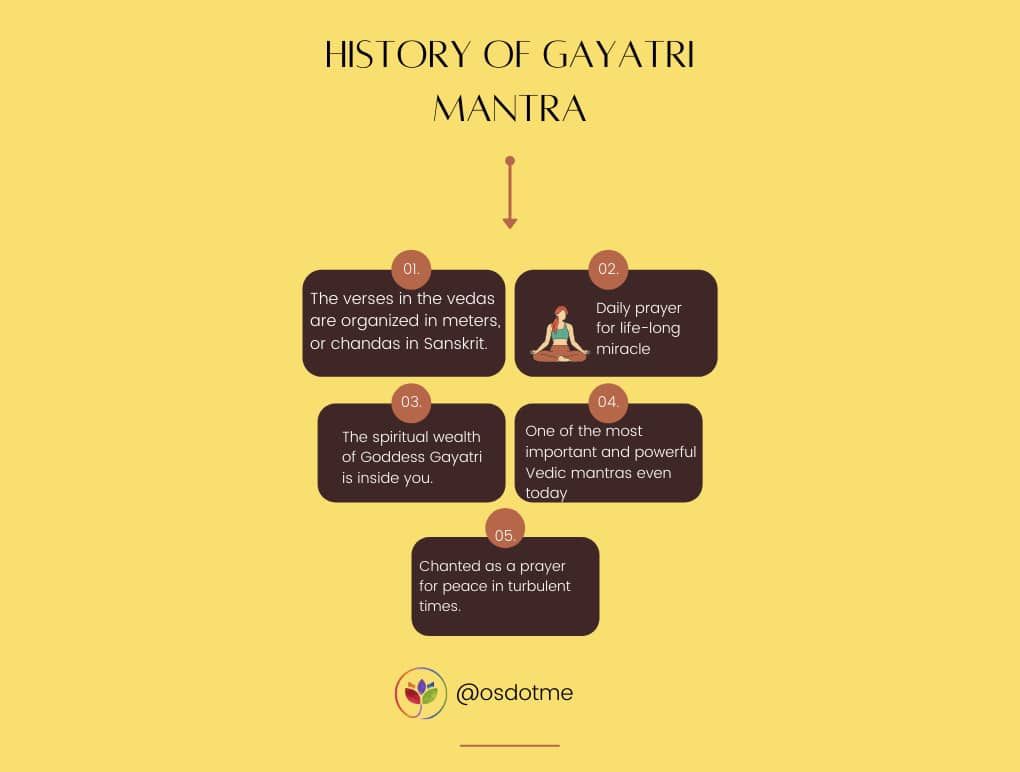
To understand the structure, power, and energy of the mantra, we have to revisit a chapter in our ancient history and see how the first rishi invoked this mantra:
Related: The Ancient Science of Mantras
The valiant king Kaushika was returning with a large number of men – his troops and his entourage. They were tired and worn out from the long battle they had just won. Passing through the woods, they thought they should camp somewhere, but the trouble was, they had run out of provisions. And without food, even the greatest warriors can’t survive, so the king was concerned. How am I going to feed my people? My soldiers are weary now, I cannot let them starve.
Just as this was going through his mind, one of the ministers said, “There is a small ashram in the woods, the hermitage of Sage Vasishtha. It’s a small place; we will not be able to feed ourselves there, but perhaps we can drink some water and relax a little.”
When they arrived at the ashram, King Kaushika prostrated before the sage who was said to be almost as old as the universe itself. The glow on his face, his flowing white beard, his snow-white matted locks on his medium-built body of a wheatish complexion looked as if twilight were meeting the morning sun. The king said with reverence, “We would just like to take a short rest here.”
“You look rather tired,” the rishi said,” and your men exhausted. Rest here for as long as you like, I’ll make meal arrangements for all of you.”
“With due respect, O sage,” the king said with a chuckle, “I don’t think you can feed us all – there are many of us – my entire army is here.”
“You underestimate the power of penance, O King,” Vasistha replied. “I am a rishi. I can feed and satiate the entire universe except for Brahma, Vishnu, and Shiva, who are satiated on their own accord alone. The one who does not seek anything, the one who does not need anything from the world, can create anything he so wishes.”
This is one of the greatest secrets of the universe: When you are fulfilled, you can manifest fairly much anything in your life. It’s when we are not fulfilled that we become impatient; we become self-centered. We become tired and narrow-minded. In chasing what we could have had, we lose sight of what we already have.
“Are you sure? Because I would not want that a few of our men are fed and the others remain unfed. Besides,” Kaushika said, “I don’t see anything here: I don’t see many pupils or disciples of yours. How are you going to cook such a massive meal?”
“Leave that to me,” the rishi said. “Why don’t you all go and take a dip in the river? By the time you get back, hot food will be ready.” The king was now quite intrigued.
Nevertheless, he did what he was told, so along with his men, they marched down to the river. Due to rains from the night before, the water was a bit muddy, yet they all bathed. Let alone food, how will he give us enough clean water to drink? When they returned, they sat down for the meal, and one after the other, they were served – plates full of food along with glasses filled with crystal clear spring water.
“Eat to your heart’s content,” the sage said. ” There is no dearth of anything here.”
Now then, it was only natural that after he had eaten, Kaushika thought, how could he do this? A sage, on his own, feeding a king and his army? It’s unheard of, quite incredible.
“How did you make this happen?” he asked Vasistha. “I have a cow, a female calf called Nandini, given to me by Indra, and Indra has a wish-fulfilling cow called Kamdhenu. Nandini is the calf of Kamdhenu, and she fulfills wishes.”
He is a sage, an ascetic. What need does he have for a calf like that? What if I had it in my kingdom. I could feed everybody; I would become supreme. I could travel with my army with just one calf beside us, and she would feed us all. We would never run out of food. We could keep conquering territory after territory.
Kaushika got thinking: This sage does not need all this power. It’s something that should belong to a king.
“So how does this work?” he asked Vasishtha. “This calf, can you make a request for anything of her? Does she grant anything you ask? For instance, if I said, fill my treasury with gold, would she do it?”
“She can grant anything you need in the present moment,” the sage said. He knew where this was going but he kept his calm. “Anything that you may require in the future, she cannot, because that goes against the fabric of nature. For nature never hoards; nature exists in the present, progressing from one moment to another. So Nandini only provides whatever you require now.”
“That will also do. I ask you, please give this calf to me.”
“I am sorry, Your Majesty, that cannot happen, because she has come here by grace, and she is treated like a mother. Besides, you are a king; you will use her solely for your material gains. I, however, have used her boons for the welfare of others: to feed hungry people.”
Kaushika was unimpressed. The desire to possess Nandini had taken over, and the basic foundation of Sanatan Dharma – respect your elders – was crumbling under the weight of ambition. “I am your king and you are in my kingdom, and I am the one who is supporting you. Therefore, I demand that you give me your calf.”
“I seek your forgiveness, but, I cannot. Nandini is under my care and protection. She is my gift, and she is Mother Divine to us.”
“Protection?” Kaushika laughed loudly. ” You, a lone, aging sage will protect her from my army? Give her to me.” Saying this, he nodded to his chief minister.
Vashishtha kept quiet to indicate his disapproval.
“Well, I will take her then.” The king moved a step in the direction of the calf. This was the beginning of their lifelong discord. “Don’t say I didn’t warn you!”
“You cannot,” Vasistha replied with a chilling conviction and calmness in his voice.
“How will you protect yourself?” Kaushika asked. “Just take a look at my army. They are powerful like the ocean. They will overwhelm you in no time at all.”
While this ruckus was going on, Kaushika’s men had untied Nandini from her post.
Vasistha whispered a mantra and used a kriya called stambhan in Tantra. Stambhan is the method of making anything stop. Vasishtha stopped Kaushika’s army. His men were rooted to the spot; they could not even move an inch. Soon, their bodies were unbearably heavy, their joints hurt, and extreme depression seeped into their heads. They became suicidal. Finally, the king apologized and pleaded with Vasishtha to forgive and release his army.
Kaushika returned to his palace with the fire of revenge burning in his heart, that whisper of a mantra seething in his ears. “I was ridiculed and had to beg for forgiveness in front of my own men. I, Kaushika, was defeated by someone who didn’t even carry a weapon. This is not befitting of my status. I need the power this sage has. In the woods, he can manifest anything and he is protected. I am no longer going to conquer territories and rule. I’m going to attain the power of this sage.” With that, he decided to renounce his kingdom and devote his life to tapas.
Tapas is penance, not in the form of just repentance, but in the form of invocation. With all his fervor, Kaushika prayed to Shiva for 1000 years, the original creator of mantras.
Lord Shiva granted his request and gave him many weapons, astras – arms that he could dislodge like divine shafts, arrows, sonic missiles – and shastras – the ones he could carry with himself like an impenetrable shield, and an unbreakable sword, and many others.
Drunk on his revenge still as new as his newly-found powers, he headed straight to Vasishta’s ashram and challenged him, demanding Nandini (the cow-calf) again.
One after the other Kaushika unleashed his weapons on Vasishtha. Vasistha took out his staff — the rishi used to carry a Brahma danda or staff — the energy of the weapons Kaushika launched at him was absorbed by the staff. Once Kaushika’s weapons were spent, Vasistha simply tilted his staff a little, casting a massive orb of energy at him. Kaushika fell down, defeated. “You are my guest,” Vasistha said. “I will not hurt you anymore. Please leave. Do something better with yourself, and don’t ask for Nandini again.”
Kaushika was foaming at his mouth, his face red like raging fire.
I’ve spent 1000 years on this, and I can’t even get a cow! Shiva’s weapons couldn’t help me at all, he thought. He continued with his tapas now meditating on Lord Brahma. After success, once again Kaushika confronted Vasishtha but unfortunately, he met the same fate. Finally, the king accepted his defeat and accepted the fact that he couldn’t win over Vasishtha. And then realization dawned on him when Vasishtha told him the secret.
“It’s not my power, O king,” the sage said, “it is but who I am. You are not defined by what you have or what you can do, but by who you are, deep inside you. You have been doing all the penance to attain something, but you have forgotten your own attainment: you have not invoked the divinity in you,” he continued. “You are simply carrying some siddhis, supernatural powers, to further your cause. You are not tapping into your real source of power, so you can have all the weapons in the world, but still won’t match me, because, for me, my strength is not in this staff,” he said, throwing it away. “It is but in who I am”.
Hearing this, Kaushika thought: No more am I going to seek weapons or harbor animosity. Instead, I will aim to reach the same level of consciousness, rather super consciousness, like Vasishtha to whom even Lord Indra bows down and the powers of the universe look up to.
Quietly, he took leave of Vasistha and sat in searing penance lasting several thousand years. And beyond he went; from a king eager to conquer territories, to a sage who ruled hearts.
With his inner eye, he had seen the one mantra that had the power to pull anyone out of any adversity, the congregation of divine sounds which could help one realize one’s wildest dreams. The only mantra he ever invoked ever since he left Vasishtha’s ashram – The Gayatri Mantra.
This story is cited by Om Swami in The Book of Gayatri Mantra Sadhana you can read the complete story of this miracle prayer in the book, with guidance on purushcharanas and mudras.
As long as you are in this body made up of five elements, you can benefit from this mantra in much the same manner as Vishwamitra and numerous other sages did. In fact, the good news is that since the mantra has already been invoked, you don’t have to put in the same effort.
This could be why even though most people chanting the Gayatri Mantra do so as a mere good morning prayer, the effectiveness is the same. The mantra is one of the most common daily prayers across households in the country and is also chanted as a prayer for peace in these turbulent times.
For more details on the history of the Gayatri Mantra, please visit its Wikipedia page.
What is the Gayatri Mantra?
Who composed the Gayatri Mantra?
The great Indian sage, Vishwamitra, is said to be the composer of the Gayatri Mantra. He was given the mantra by the Divine itself, as a reward for his searing penance and meditation. It first appears in the Rig Veda, written around 3500 years ago, and is also known as the Savitri Mantra. The Gayatri Mantra comprises twenty-four syllables, organized within a triplet of eight syllables.
Which God is the Gayatri mantra dedicated to?
The Gayatri Mantra is dedicated to the Vedic deity Savitr, also sometimes known as Surya, the Sun God. A powerful and effective way of aligning our energies with this deity, the provider of solar energy all around the world, is by undertaking the month-long Karthik Surya Sadhana. The best part? It already comes with inherent blessings!
Who are the gods/goddesses in the Gayatri Mantra?
There are twenty-eight types of the Gayatri Mantra, the most eminent of which is Savitur Gayatri. Savitur Gayatri is also known as Ved Mata Gayatri (The Mother of all the Vedas), and Surya Gayatri (The Sun God) as light and knowledge are synonymous with each other.
One who is filled with light is also filled with knowledge and one who is filled with knowledge is also filled with light. The one who is filled with both light and knowledge is ultimately filled with love.
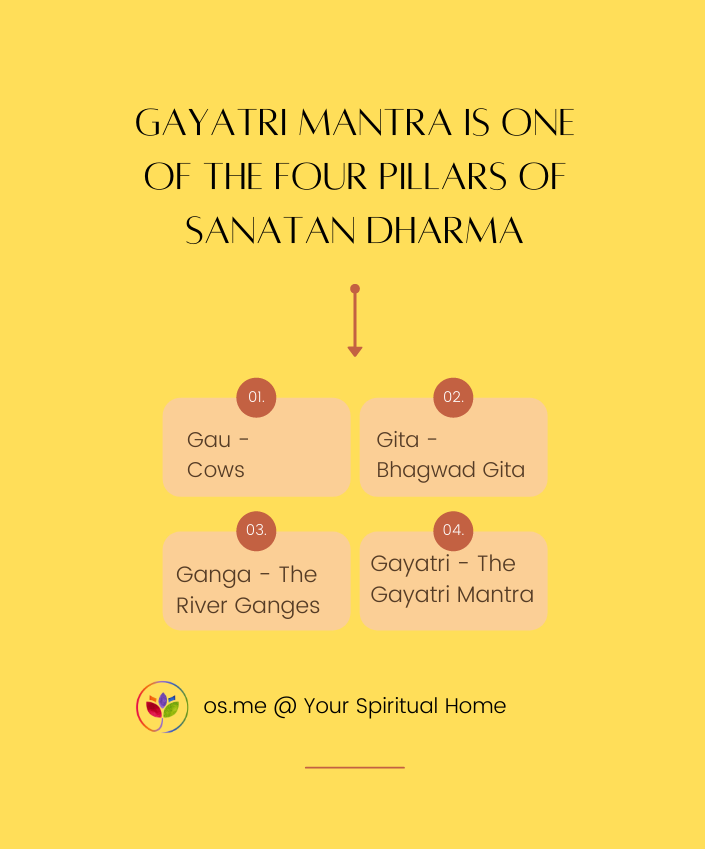
Sanatan Dharma, also known as Hinduism, stands on four pillars:
1. Gau – Cows
2. Gita – The Bhagwad Gita (the scripture which translates to The Song of the Lord)
3. Ganga – The River Ganges
4. Gayatri – The Gayatri Mantra
The verses in the vedas are organized in meters, or chandas in Sanskrit. Krishna says, “Gayatri naam chandasaam aham” *(The Bhagavad Gita 10.35).
The full verse is : brihat-sama tatha samnam gayatri chhandasam aham masanam marga-shirsho ham ritunam kusumakarah.
— Of the vedas, I am Samaveda, of the meters, I am Gayatri, of the months, I am Margashirsha, and of the seasons, I am spring.
This also hints at the esoteric aspect of the sadhana, where one may invoke this mantra for both material and spiritual upliftment in the month of Margashirsha (usually from mid Nov – mid Dec, but please consult a panchangam).
Under the Gayatri chanda, the Gayatri Mantra sits in the the third canto of the 62nd Chapter, in the 10th verse. This chanda includes many mantras, the Gayatri Mantra is its most significant. Here, it does not begin with the familiar Bhur-bhuvah-svah. The mantra found there is:
Tat-savitur-varenayam
Bhargo-devasya-dhimahi
Diyo-yo-nah-prachodayat.
The complete and recommended mantra, however, begins with Om bhur-bhuvah-svah:
oṃ bhūrbhuvaḥ svaḥ
tatsaviturvareṇyama
bhargo devasya dhīmahi
dhiyo yo naḥ pracodayāta
The structure of this mantra is referred to as chatushpadi. Chatus means four and padi means limbs, which correspond to the four vedas and four pauses in the mantra.
There are twenty-eight types of the Gayatri Mantra, the most eminent of which is Savitur Gayatri. Savitur Gayatri is also known as Ved Mata Gayatri (The Mother of all the Vedas), and Surya Gayatri (The Sun God) as light and knowledge are synonymous with each other.
One who is filled with light is also filled with knowledge and one who is filled with knowledge is also filled with love.
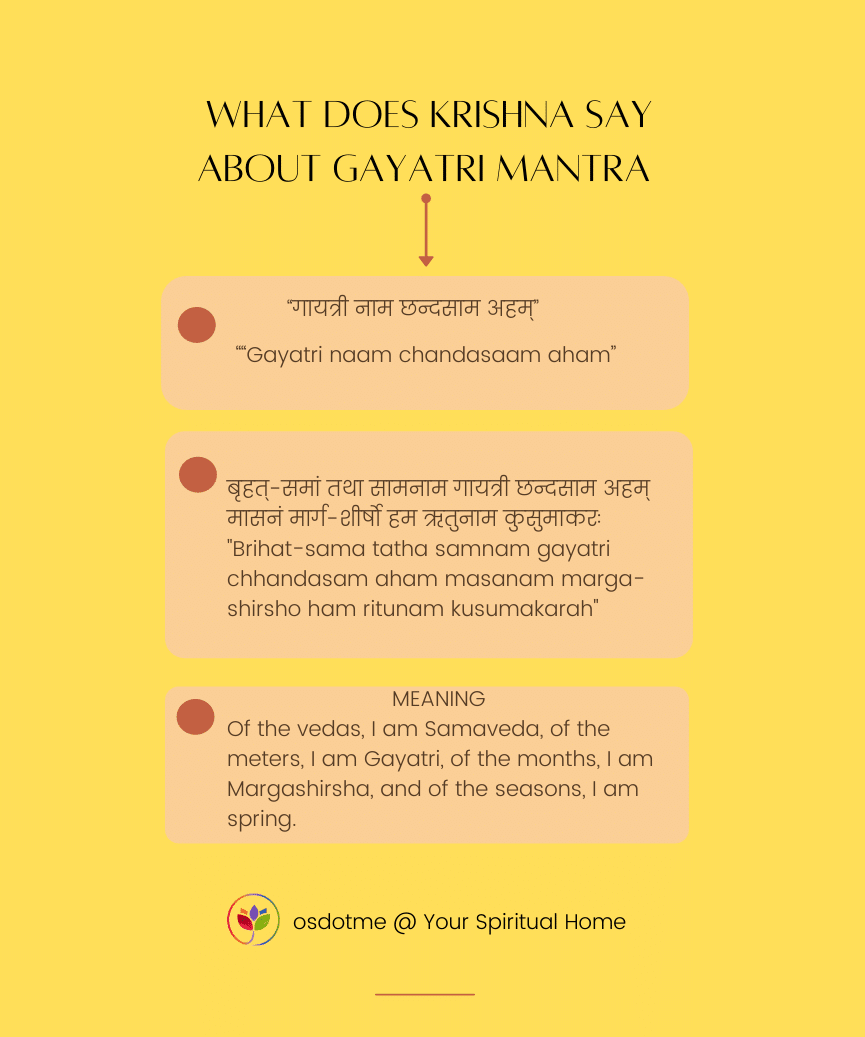
The Esoteric Meaning
When and why did the Gayatri Mantra attain its important status?
The Gayatri Mantra first came to light when it appeared in the Rig Veda, 3500 years ago. It has since been considered one of the four pillars of Sanatan Dharma, and is an integral part of most Indian households today.
Practitioners of the Gayatri Mantra are said to be bestowed with wisdom and intellect. It aids in building single-pointed focus and is a way to receive the blessings of Mother Divine.
Why is Gayatri Mantra regarded as the best mantra?
The Gayatri Mantra is considered the most universal of all Sanatan Dharma mantras. It invokes the Supreme Being as the principle of knowledge and seeks illumination of the intellect. The Gayatri Mantra is dedicated to Goddess Gayatri (also known as Savitri), the Mother of the Vedas and the Goddess of the Five Elements. She represents the ultimate knowledge and bestows the mantra practitioner with concentration, intellect and insight.
Om Swami explains its esoteric meaning, plus the four states of consciousness, the four states of material nature, the technical details and meaning of each word of the mantra, and how it plays a role in transporting a human to the level of supreme consciousness.
In Hindi with English subtitles:

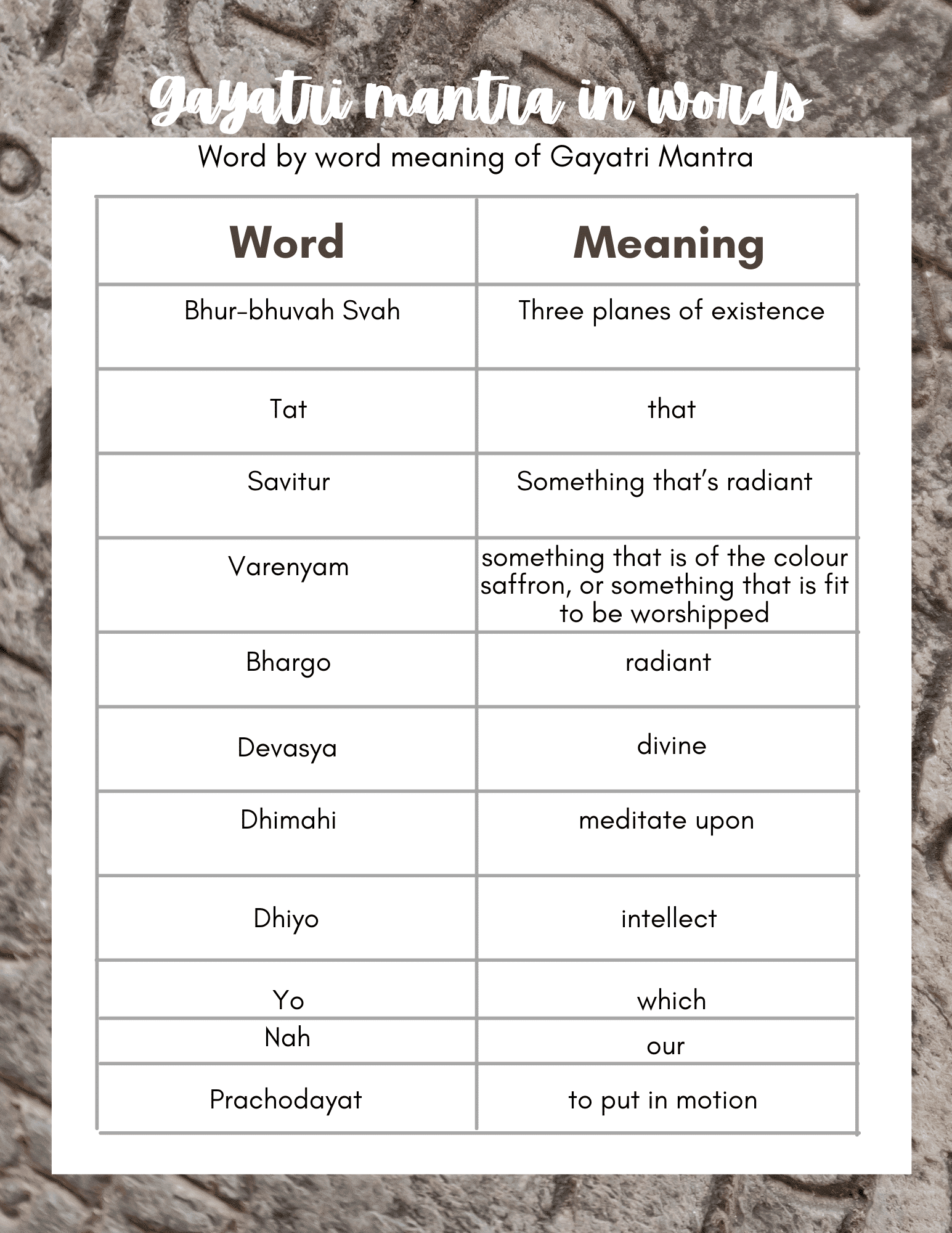
Bhur, Bhuvah, Svah — The three planes of existence, the three types of consciousness, the three modes of material nature: sattva, rajas, and tamas (goodness, passion, and ignorance).
Tat — That.
Savitur — Something that is radiant. Also the name of the sun, and its radiant, divine energy.
Varenyam — Something that is of the colour saffron, or something that is fit to be worshipped.
Bhargo — Radiant
Devasya — Divine
Dhimahi — Meditated upon
Dhiyo — Intellect
Yo — Which
Nah — Our
Prachodayat — To put in motion.
In full it means: We are now meditating upon the one who alone is fit to be worshipped. May the divine radiance, that divine energy that is full of light, guide our intellect. May it put our intellect in motion, so we have a wealth of wisdom to put to use.
How to Chant Effectively
The two primary requirements for mantra chanting are willpower and purity of intention. Discipline and concentration will then follow on their own. What made this possible for Navjot Lidder? She chanted the Gayatri Mantra everywhere she could including, on a family holiday, in the pool! Describing snippets of her powerful experiences while chanting the mantra effectively, she shares her dreams and visions, and how understanding dawned in hindsight. The ability to harness the power of any mantra lies with us.
Ultimately, the whole sadhana (practice) is to purify yourself. Otherwise, chanting has little meaning at the end of the day. If we fail to purify ourselves internally, then no mantra will ever yield any siddhis or powers. And siddhis will come to you, simply if you are purified.
Chanting a mantra without awareness is like chanting “Food, Food, Food”, and expecting your hunger to be satisfied – as if you could say ‘Pasta’ or ‘Pizza’ and not need to feed yourself. If you reduce a mantra to a verbal activity, chanting recklessly just to finish your rounds, it won’t get you anywhere.
In this video Om Swami shares how to chant mantras effectively:

The Benefits
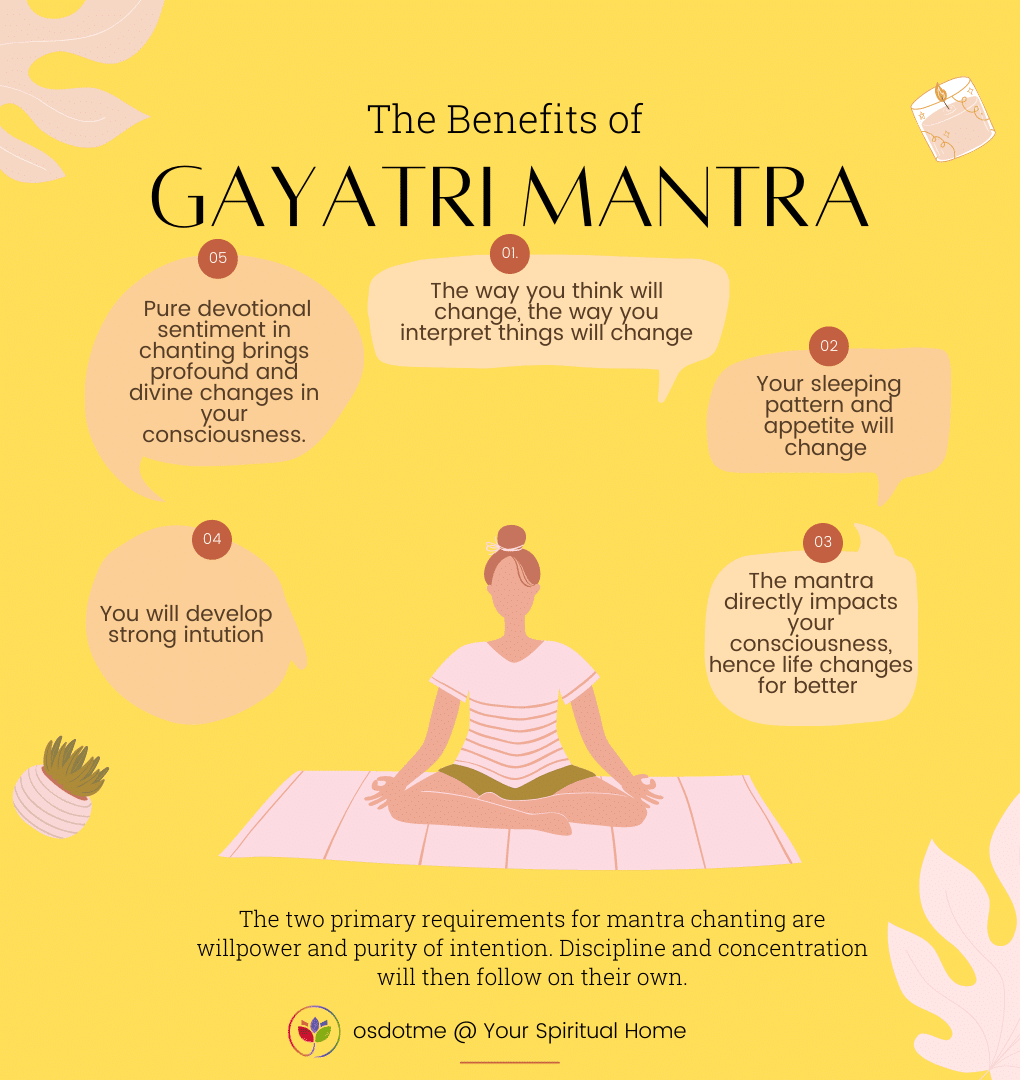
Watch this video to understand how disciplined and intense sadhana (practice) brings about a profound change in you. Also, learn what kind of people will not benefit from it.

The Best Time to Chant the Gayatri Mantra
Om Swami says, the more you chant the more you can use that energy when things are not going well in your life. There are three main Sandhyas (times to chant) – in the mornings, afternoons, and evenings. Pick any of those times or all three; there are no restrictions as such for this beautiful daily prayer.
Learn more about this, plus initiation and the presence of a guru in your life:
In the beginning, when you chant, you follow strict discipline, so to speak. You might only sit down and then chant. But as you progress, the chanting becomes a part of your life, and you can chant 24/7.
Most Commonly Asked Questions:
Does chanting of this mantra improve memory?
When you chant this mantra, there are two channels in the human body. There are three but physically you can only trace two. One is called ida nadi, also known as the lunar channel. The other one is called pingala nadi, also known as the solar channel. The solar channel regulates psychic heat in the body as well as the physical heat in the body. It is when you breathe through your right nostril. When you chant this mantra, it actually boosts your right brain. It is very good for strengthening the right side of the brain. To learn more, watch this video.
How does one breathe along with the Gayatri Mantra?
How to breathe during mantra chanting? Om Swami says, if one masters the art of breathing with the mantra, then they can end up chanting the mantra all the time. Their breath will also become regulated and controlled. Try breathing in while you are chanting, and breathing out while you are chanting. Inhalation while doing one full round of Gayatri mantra is good, but if this is too much then inhalation at the start of each round is a good practice.
How does one attain Mantra Siddhi?
In this discourse, Om Swami addresses the topic of attaining mantra siddhi, and the role of your environment that contributes to it. There is a process to attain Mantra Siddhi. Whether you do it through the Vedic way or the Tantric way, the process cannot be broken. Siddhi’s have different levels. In the first level, you do not know whether you have attained the siddhi or not. In the second level, the deity or the energy awakened by that Siddhi can talk to you anytime but you can’t tell them when not to talk. As you further progress on the path of the Sadhana then you attain the higher level Of siddhis. In which you awaken that energy at your own will, you get the answers at your own will and you give answers to someone at your own will. Siddhis which are of even a higher level are the one In which neither you ask anything nor say anything. Because there is no need since the energy is with you all the time and it will do what it has to do.
What is the correct rhythm to chant the Gayatri Mantra in?
Om Bhurbhuvah Svah,” first pause
“Tatsaviturvarenyama,” second pause
“Bhargo Devasya Dhimahi,” third pause
Dhiyo Yo Nah, Pracodayat,” fourth pause
Can non-brahmins chant this mantra?
Any person, of any age, religion, ability, or background can chant with or without initiation.
How many times is the mantra is to be recited? How many times to chant daily?
You can start with 11 times daily and gradually increase to 21, 51, 108 times to 1008 times. As the number of times chanting is important, doing it correctly is equally important. You may be chanting Gayatri Mantra 108 times, but if you are not doing it correctly, it’s fruitless. Its easier to start small and gradually increase the chanting.
How does one chant in the mind?
It is always better to chant the mantra internally.If you are eulogizing Bhagwan out of your devotional sentiments then you can chant loudly. For example, sahasranamas, stutis are generally done loudly. However, if you are chanting a mantra it is best to do it internally. Internally, you can do it loudly though. There is a big difference. When you are doing chanting for long periods, you will have to divide the mantras into different parts to maintain concentration. In order to maintain sharpness, clarity, and lucidity when you are chanting for a long period of time, sometimes you need to slow it down or go faster or murmur or chant loud to maintain the concentration. So, you can chant loudly but inside. You can watch this video to know more about mantra chanting.
If you are drawn towards this mantra, the door is wide open for you. You have only to begin.

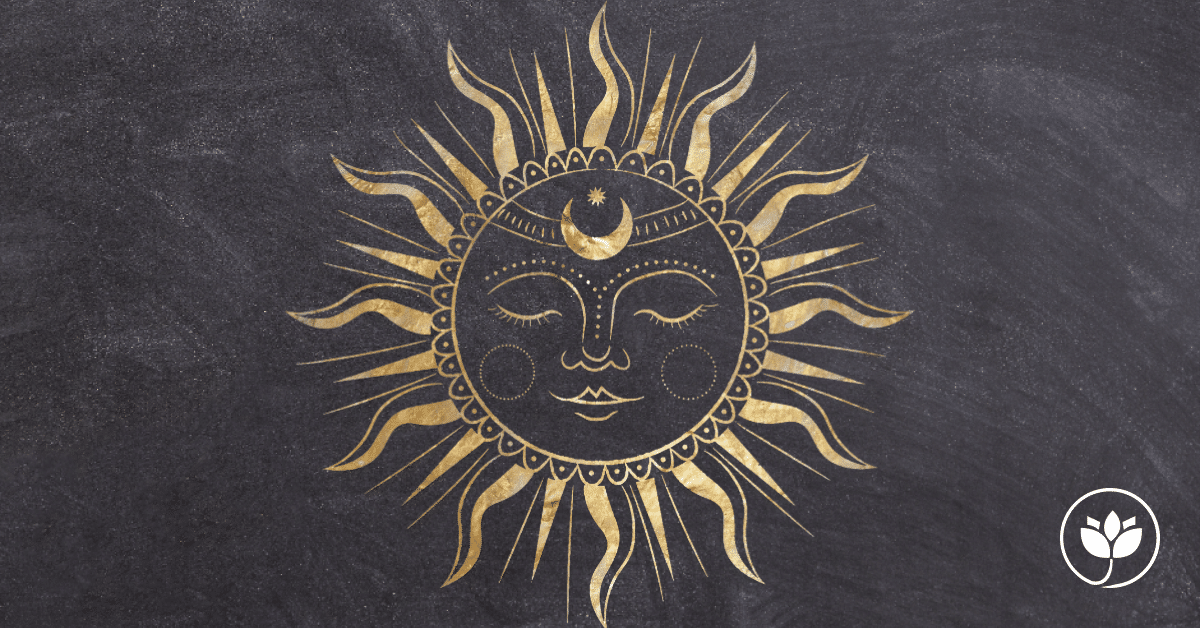

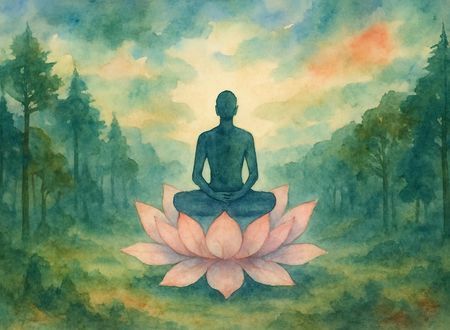


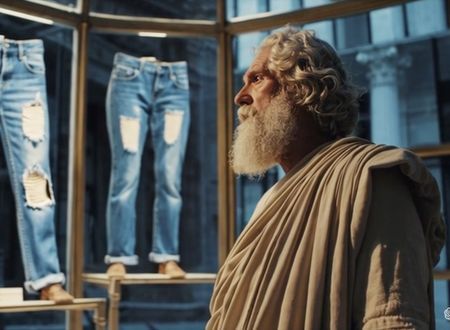
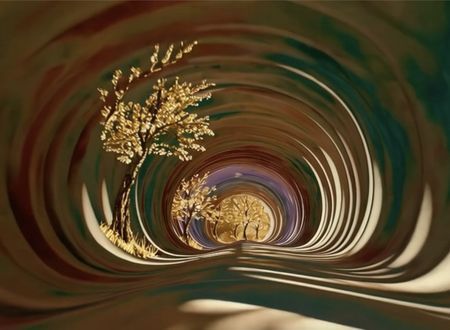


Comments & Discussion
17 COMMENTS
Please login to read members' comments and participate in the discussion.